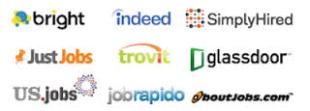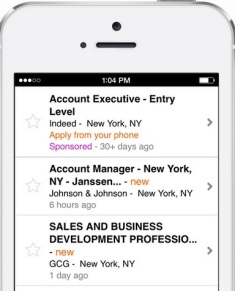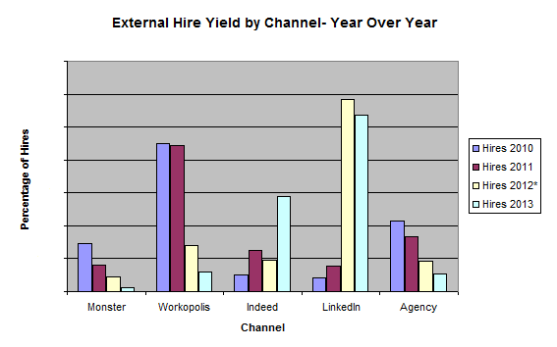A few months ago I did a presentation to a group of global recruitment professionals on social recruiting tools and sourcing channels. The group comprised of HR leaders and many “seasoned’ Recruiters; some of which had been in the industry for more than 15 years. As I started showing the breakdown of hire yield by sourcing channel, a single hand went up and delicately asked “What’s a job aggregator?” As the question was asked I could see heads bobbing in unison relieved that someone had the courage to ask the question. I have to admit, that with all the traction job aggregators have made over the last 5 years I was surprised that it was still such a mystery to Recruiters. So before I go any further I thought I would do a quick recap of what a job aggregator is.

In its simplest form job aggregators are true “job search engines” that collect job postings from other sites across the web (including employer career sites and paid job boards) and store them in a very large database where they are searchable by job seekers. It’s appealing because jobs can be found in one place rather than spending time trying to find every possible place a job would be posted.[1]
Over the last decade job aggregators have evolved from just a central job repository to a sophisticated multi-dimensional digital advertising platform. It’s taken the traditional post and prey model and turned it upside down. So much so that sites like Indeed.com boast job seeker traffic to the tune of 140M+ global visitors each month[2]. In my opinion job aggregators are changing the sourcing game by:
- Aggregating job postings at no cost to the employer or job seeker. In other words it’s FREE. Employers don’t have to pay to post their jobs and candidates don’t have to pay to access job postings unlike the pay to post model of
 traditional job boards around the world.
traditional job boards around the world.
- Being search engine optimized. If start your search on Google, Bing, Yahoo, etc. Job results returned are indexed to the aggregator first, often ahead of the employer site and job board sites. Their high search engine ranking means traffic is directed back to the aggregator site even if the job is advertised on a paid job board!
- Introducing a Pay per Click (PPC) model for jobs. This brilliant idea piggy backs on internet advertising. Basically it provides employers the ability to sponsor jobs so they can rank higher in search results and be presented to candidates ahead of other jobs that appear for free. Costs are only incurred when a job seeker clicks on the link. Meaning you only pay for results.
- Enabling employers to set their own budget. Employers are no longer required to pay huge lump sum, upfront, costs for postings. Instead they can set a monthly or one time budget and choose to use it as it suits them.
- Being mobile optimized. As mobile has evolved, so have the aggregators. Their minimalist approach enables an easy and seamless user experience. Indeed.com has confirmed that about 49 % of global traffic to their site (69M+ monthly visitors) comes from mobile devices[3].
This approach has developed into a model that is fast becoming an industry standard. Employers are paying more attention as aggregators have slowly amassed hire yield away from traditional job boards and staffing agencies. I personally saw this shift in my own organization. The chart below is a simple metric I used (and communicated to the HR Team) to gain insight into our sourcing channel trends. It revealed the decline of job boards and agencies and the rise of social media and job aggregators. I wasn’t alone in seeing this trend. Many large, global employers I spoke to have also seen this trend and like me, started taking their budgets reserved for job boards and investing them in job aggregator and search engine campaigns. Leveraging the pay per click model. It’s a clear and tangible indicator that job aggregators have disrupted the industry standard for job postings.

It’s this kind of employer insight that has forced job board vendors to rethink how they offer their products and services to remain competitive. The impact is material. In October Canadian job board giant Workopolis launched Social Job Share (SJS), a job distribution product that shares jobs on their website to social media sites such as LinkedIn, Twitter, Facebook, etc. In May 2014, Monster Worldwide announced its move to a job aggregator, pay for performance model.
 Job Aggregators haven’t only challenged job board vendors. Their disruption has also extended to social networking platforms. Facebook launched its Social Job Partnership (SJP) job posting site in 2012. They chose to aggregate job postings instead of asking employers to pay to post. Even LinkedIn has not been immune to its influence. In June 2014, they announced they would be aggregating job postings to their active job seeker population in the US. A strategy shift from its paid job slot offering.
Job Aggregators haven’t only challenged job board vendors. Their disruption has also extended to social networking platforms. Facebook launched its Social Job Partnership (SJP) job posting site in 2012. They chose to aggregate job postings instead of asking employers to pay to post. Even LinkedIn has not been immune to its influence. In June 2014, they announced they would be aggregating job postings to their active job seeker population in the US. A strategy shift from its paid job slot offering.
Despite the higher yield of candidate hires and lower ROI, many employers struggle to completely relinquish their use of job boards to aggregators siteing low brand awareness. Recruitment functions complain Manager’s seem to have little or no awareness of brands like Indeed or Simply Hired compared to well known brands like Monster, Naukri, CareerBuilder, Workopolis, etc. The success of aggregators should be a signal to recruitment functions that it’s more important to invest where the candidates are. Manager awareness should not be the driver of a sourcing strategy. Recruiters should be using metrics such as source of hire to educate Managers and build awareness. It certainly doesn’t hurt aggregators to invest in building brand awareness either.
There’s no doubt job aggregators have become a game changer. Their simple, yet effective model has transformed the concept of paid job postings. This forward thinking approach will continue to chart the way we think of sourcing and applicants.
 You may wonder; if aggregators are posting jobs for free, why should employers invest? I love this question because I answer it the way any savvy business person would. If free is yielding a good ROI, imagine what would happen with a real investment?
You may wonder; if aggregators are posting jobs for free, why should employers invest? I love this question because I answer it the way any savvy business person would. If free is yielding a good ROI, imagine what would happen with a real investment?
I’d love to hear your stories/experiences about how job aggregators have impacted your sourcing strategy. Contact me @annzaliebarrett or through LinkedIn.
[1] http://www.job-hunt.org/findingjobs/findingjobs_job_aggregators.shtml
[2] Indeed Interactive Conference – 2014
[3] Indeed Interactive Conference- June 2014
